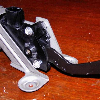Condition:Excessive pressure on the occupant during normal wear, the webbing cannot be extracted, excessive slack in webbing does not retract
Possible Sources: Front safety belt retractor and tongue.
Possible Sources: Rear safety belt retractor and tongue.
Action: CARRY out the component Functional Test in this section. INSTALL a new retractor if necessary
Component Test
Carry out the appropriate Functional Test(s) as determined in Inspection and Verification.
Functional Test I (Buckle and Tongue)
The safety belt buckle and tongue assembly must operate freely during the latching and unlatching function. Fasten the safety belt by inserting the tongue (male portion) into the buckle (female portion).
Verify the following during the latching sequence:
Tongue insertion is not hindered by excessive effort.
A "click" is heard when the buckle latches the tongue.
Verify the system integrity by forcefully pulling on the belt webbing.
Unlatch the belt by fully depressing the buckle release button, and allowing the belt to release and retract.
Verify the following during the unlatching process:
Push-button depression does not require excessive effort.
Tongue can be removed easily from the buckle.
Repeat the above steps three times.
If the inspection reveals an obvious concern(s) that can be readily identified, install a new safety belt buckle or safety belt retractor assembly as required. Do not attempt to perform any repair on the buckle and tongue assembly. If a concern still exists with either component, a new safety belt buckle or safety belt and retractor assembly must also be installed.
Functional Test II (Retractor)
The safety belt and retractor assembly must be freely operational for extraction and retraction of the safety belt webbing between full extension and in-vehicle stowed positions.
Extract and retract the safety belt between the full extension and stowed positions.
Verify the retractor operates without excessive effort or binding.
Install a new safety belt buckle retractor and tongue assembly if no obvious concerns are noticed and the complaint has been verified.
Functional Test III (System Road Test Inspection)
NOTE: If the RH or the rear safety belts are to be tested, a passenger must be used.
Fasten the safety belts and proceed to a safe area.
Attain a speed of 8 km/h (5 mph).
WARNING: The driver and passenger must be prepared to brace themselves if the retractor does not lock.
Test the safety belts.
Grasp the shoulder harness and prepare to lean forward.
WARNING: The maximum brake application should be on dry concrete or equivalent hard surface, NEVER on wet pavement or gravel.
WARNING: The driver and passenger must be prepared to brace themselves in the event the retractor does not lock.
Make a maximum brake application without a skid.
NOTE: Do not jerk on the safety belt webbing when carrying out this test. Lean forward slightly when the brake application is made.
The safety belts should lock up with minimum webbing extension.
If there is a lockup of both shoulder straps, the safety belt assemblies are functioning correctly. Should either or both retractors fail to lock up at the 8 km/h (5 mph) speed, repeat the test at a constant 24 km/h (15 mph) speed. (This test must be carried out with a RH front or rear passenger if the RH front or rear outboard safety belts are to be tested).
CAUTION: Before installing a new safety belt assembly, inspect the mounting area for damage and distortion. If the retractor of a new safety belt assembly has been bolted into a damaged or distorted mounting area, the retractor could be warped and may not function. If this is the case, remove the retractor, return the sheet metal to the original configuration and install another complete safety belt assembly.
If either or both retractors do not lock up at the 24 km/h (15 mph) test, return the vehicle for service of malfunctioning safety belts.
Functional Test IV (Automatic Locking Retractor)
WARNING: After any vehicle collision, the safety belt system at all seating positions (except driver, which has no "automatic locking retractor" feature) must be checked by a qualified technician to verify that the "automatic locking" feature for child seats is still functioning correctly, in addition to other checks for correct safety belt system function. A new safety belt and retractor assembly must be installed if the safety belt assembly's "automatic locking retractor" feature or any other safety belt function is not operating correctly when checked according to the procedures in the workshop manual. Failure to install a new safety belt and retractor assembly could increase the risk of injury in collisions.
Position the seat back into the full up position.
Position the height adjuster in the full down or up position.
Latch the seat belt buckle and tongue assembly.
Pull the shoulder belt out until the automatic locking retractor (ALR) feature is activated.
Release the shoulder belt and allow it to retract until it stops.
Pull on the shoulder belt to check that the belt has remained in the ALR mode. If the belt is not locked, install a new safety belt and retractor assembly.
Unlatch the safety belt tongue from the buckle and allow the safety belt to retract to its stowed position.
Pull the shoulder belt to verify the retractor assembly has converted automatically out of the ALR mode. If the shoulder belt remains locked in the stowed position, install a new safety belt and retractor assembly.










